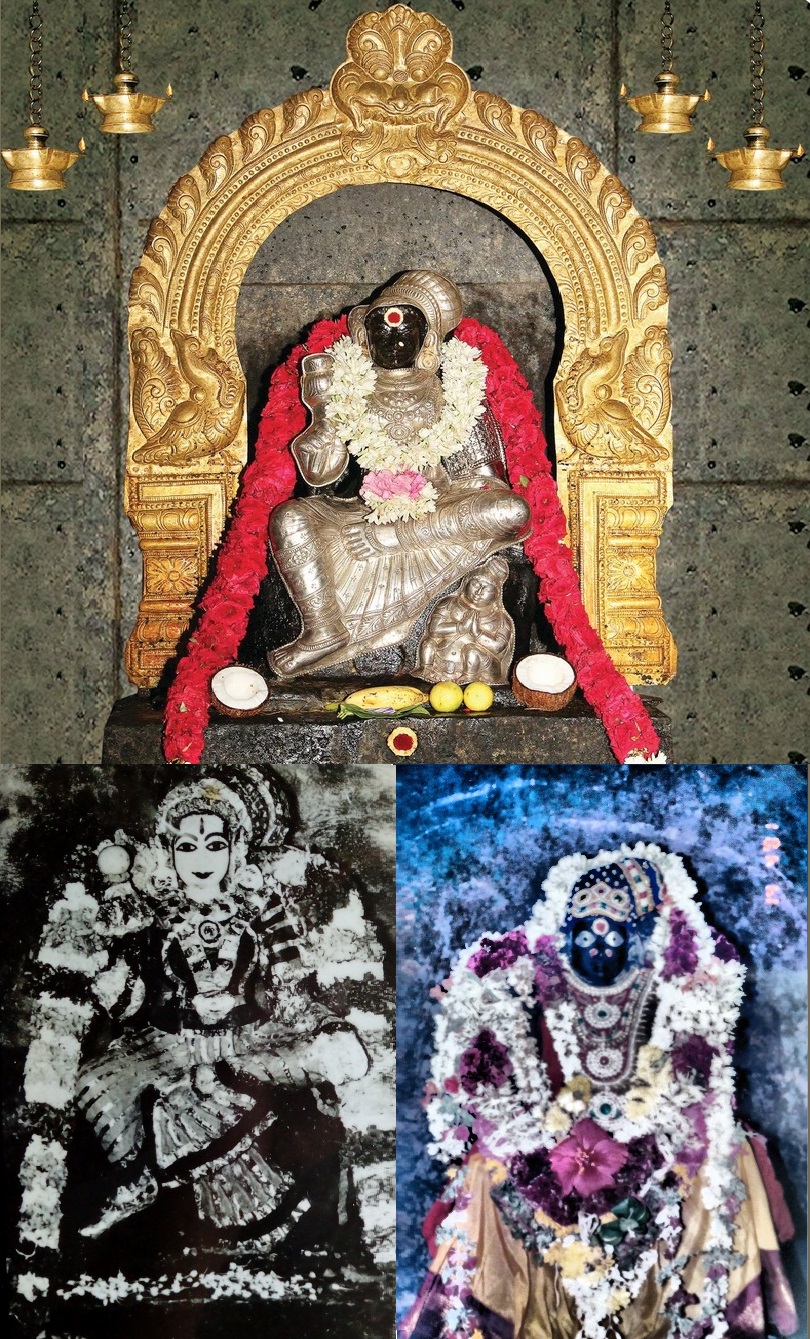
Origin and history of
Siththadi Goddess Kathayee
Written by : Santhipriya
-1-
Over six hundred years old Goddess Kathayee (who is in the other form of Goddess Valli, the consort of Lord Muruga) temple exist in a small village called Sithadi which is in Kumbakonam and Mayavaram route in Kodavasal Block of Thiruvarur District in the state of Tamil Nadu. This is very small temple built on a vast temple land on the banks of river Mudikondan. This village, Sithadi near Nannilam lies 33 KM away from Mayavaram and from Kumbakonam it is 13 KM away.
There are myths and folk lore across Indian continent in varied significance on Village deities, one amongst them being Goddess Kathayee. Based on lore one believe that the worship of Goddess Kathayee may have existed since thousands of years ago in the villages in Kaveri delta and parts of Chola mandala which comprised territories of present day Thanjavur, Mayuram, Trichy, Kumbakonam, Chidambaram etc in which half the lands were agricultural or barren fields. Some of the learned pundits suggest that even before 1500 to 2000 years during the rule of Chola Kings, the worship of Goddess Kathayee may have prevailed in some of the villages controlled by them if you keep in mind that she has been the tutelary deity of many families even today whose several ancestors were natives of villages in Kaveri delta and adapted her as their family deity. This impression is gained in view of few temples of Goddess Kathayee seen in some of the villages in Kaveri delta where she was worshiped as village deity or Grama devatha even to this date.
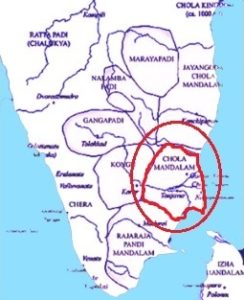
Some also believe that Lord Muruga married Goddess Valli in the present temple site of Siththadi even though there are stories to suggest that Lord Muruga married Goddess Valli in Kathirgamam, a village in Sri Lanka. Therefore one should better understand the background of Goddess Kathayee. You will find stories of Purana and legends suggesting that the divines have taken several births in the form of human in Bhoologa (earth) to atone sins and redeem some of the curses incurred by them on various accounts. Such list included even few of the divine pairs who had to stay away from their husbands or wives as long as even up to thousand years. At the end of the curse, when they reunited they remarried their partner divines. One has to deeply etch in their mind that there was no question of divorce as far as divines were concerned, and the status of separation and remarriage meant temporary disconnect between husband and wife divines for any reason. At the end of the penances and re-join, shadow function similar to marriage was organized like flashback of their initial union. Not every one of the divine pairs who remained separated enacted the drama of remarriage. According to the learned pundits, the act of remarriage, which was indeed flashback of their initial union was performed for yet another reason by few divines. Many saints, celestial and Rishi munis who could not witness the divine marriages longed to see the same in their life time and prayed to the divines accordingly and complying to their genuine wishes, the divine pairs re-enacted marriage very similar to that of their initial union. Such remarried divines according to the Puranas included divines like Lord Shiva-Goddess Parvathi, Lord Vishnu- Goddess Lakshmi and Lord Muruga with Goddess Valli who has performed the act of flashback marriages several times in Bhoologa. In this background we can certainly believe the theory that Lord Muruga married Goddess Valli in Siththadi village and also in Kathirgamam in Srilanka before Goddess Valli turned into Goddess Kathayee in Sithadi.
Similar to the legends on Village deities, there are folk tales and lore on Goddess Kathayee as well. The very fact that Goddess Kathayee worship sites are seen in some of the villages in Kaveri delta indicate that she must have also been worshiped as village deity in those villages on par with other village deities to save their villages from the evils and acts of natural disorders. While most of the village deities called grama devathas were worshiped in non agamic manner only in Siththadi temple she was offered Pooja with agamic rites which itself speak of the glory of Sithadi Goddess Kathayee. Interestingly in another small temple in the same Sithadi village Goddess Kathayee is worshiped as village deity.
Going by the stories spread by word of mouth and the temple lore one tends to believe that most of the shrines for Goddess Kathayee in Kaveri delta may have sprung up only after Goddess Kathayee temple surfaced in Sithadi village. Remember that other than Siththadi Goddess Kathayee temple, none of temples in the villages for Goddess Kathayee have temple history of their own attributing reasons for the manifestation of Goddess Kathayee and site the worship of rulers and other local stories to glorify Goddess Kathayee. The probable periods in which they had come up is also not clearly known.
There are sufficient reasons to believe that in Kaveri delta, during Chola dynasty, temples for Goddess Kathayee may have existed in few of the villages, reason being some of the Chola Kings held Goddess Kathayee as their family deity and worshiped her. King Vikarama Chola-I who succeeded King Rajaraja Chola has continued to worship Goddess Kathayee as his family deity. This information is found in the temple history of Kattu Mannaar temple for Goddess Kathayee which is reportedly 500 years old. They called her as Poonguraththi meaning ‘Fowler community lady’ which is because the Goddess met the main adversaries of the King in the form of a tribal (Fowler) lady and settled their dispute in peaceful manner. Therefore he enshrined a statue of Goddess Kathayee by the side of Goddess Pachchai Vaazhi Amman (Goddess Parvathi) in the temple and continued to worship here thereafter. Since Goddess Parvathi appeared most of the time in green saree, she adored the name Pachchai Vaazhi Amman, Pachchai meaning green in colour.
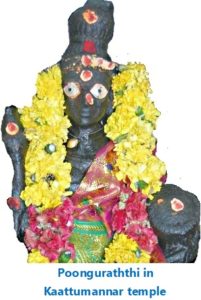
Interestingly in Sithadi temple she is seen in the form of a sculpted granite stone holding a Lotus flower in the right hand. The left hand rest on the folded left thigh which is rested on the right thigh. A saint is also seen sitting below her left leg. Contrary to such a granite sculptured statue, in most of the other temples the appearance of Goddess Kathayee is in the form of colorful terracotta idols with a child in her lap or hand or seen her face showing up to burst, all of which clearly establish that they have been locally carved out or shaped like Goddess Kathayee and installed and not naturally traced out.
Doubts were cast on how the sculpted granite stone statue came to be established in Sithadi temple alone. During the rule of Chola Kings few bigger and smaller temples have been built in which the sculptures have carved out the forms of divines on granite stones according to the norms prescribed in Shilpa Shastra which prescribed specific dimensions and features for each of the deities. There were numerous occasions when many of those temples and smaller shrines were destroyed or submerged in the flood waters or got buried due to natural calamities such as heavy floods and cyclones besides attack from invading enemy forces of other Kingdom. Even today numerous ruined temples stand testimony to this fact in Kaveri delta in which the divine statues have been sculpted on granite stones in the most intricate manner. Quite possibly the idol of Goddess Kathayee enshrined in Sithadi temple may have also been from one of those ruined village shrines and submerged into the river to be found in Sithadi by the Brahman priest. This is one of the reasons only.
To those who argue how to believe that finely sculptured divine statues were indeed enshrined in those ruined temples, look at the case of Lord Vaitheeswaran temple in the same Kaveri delta. Initially there were five Lord Vaitheeswaran temples in that area. Two of the first built temples amongst them have been found destroyed. One of them, huge in size and built nearly 1300 years ago in vast acres of land was in Manippallam Village near Seerkazhi was found completely vandalized with broken pillars and culverts strewn everywhere in an area of one acre land. While beautifully sculptured idols were reportedly stolen away by thieves or shifted even to states like Kerala to enshrine them in some temples, those left behind were found partially broken. The Manippallam Villagers brought the remains of the dilapidated temple and constructed a newer temple for Lord Vaitheeswaran (Lord Shiva) in their village in recent years. The second Lord Vaitheeswaran temple still remains in shambles in an interior village under roof of a hut. Both the temples have beautifully sculpted statues of divines including Shiva Linga. These details are found in the temple history of Manippallam Vaitheeswaran temple.
See the second case of nine Shiva Linga temples reportedly established by Lord Murugan. Before Lord Muruga went on war with Soorasimman, he was to receive a powerful weapon called Vel (Trident) from Goddess Parvathi. However she advised Lord Muruga that before receiving the Vel, Lord Muruga should first offer prayers in nine Shiva temples in and around Sikkal where he would finally enshrine himself after annihilating Sooran. Lord Muruga established nine temples for Lord Shiva in nine villages like Perumkadambanur, KadambaraVazhkai, Vallamangalam, Pattamangalam, Sottalvannam, Thiruthevoor and Othiyoor in and around Sikkal, offered prayers there and then only went to receive the Vel from Goddess Parvathi. Today those ruined temples remain completely in dilapidated condition, unable to even offer worship and some of the beautifully sculpted granite stone idols of divines including Shiva Linga of those temples are found scattered in open fields and worshiped by locals. See below picture of one of those ruined temples:
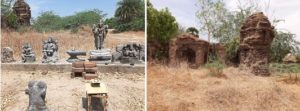
It is quite possible that several thousand years ago Goddess Kathayee may have manifested in a shrine in the present temple site in which Goddess Kathayee’s idol made of granite stone may have been enshrined. May be in nature’s fury, the shrine may have been damaged and idol drowned into the river during flood or got buried in some sort of quakes. Since Goddess Kathayee wanted to stay there, she may have enacted a drama through Kanchamalai muni to get her re-established in the same place through the local Brahmin who brought her idol from inside the river. Valid reasons are many to believe that the granite stone idol of Sithadi Goddess Kathayee recovered from inside the river may have been naturally shaped thus.
Reading stories in Purana further you will notice that many divines travelled to Bhoologa to redeem their curses and sat in tapas in invisible form in some isolated places for even several thousand years. Some of the divines who stayed in the form of humans for some cause when returned back to Devaloga left their human body in the same form in which they lived in earth. The bodies being divine, never perished and over centuries became granite stones over the years carrying the same form in which they lived. It is possible that Goddess Valli in the form of Goddess Kathayee with three headgear too may have stayed in the present temple site of Sithadi and when she went back to Devaloga along with Lord Muruga, she may have left behind her divine energies into her human body which got buried inside the land. Over the years when Mudikondan river flew over the same land, the statue of Goddess Kathayee with three headgear may have been found and taken out centuries later to get enshrined in Sithadi village temple. The granite stone idols of Lord Venkateswara of Tirupathi and Lord Shiva in Kedarnath and Badrinath stand testimony to this belief.
Generally Goddess Valli is seen seated in several temples flanked by Lord Muruga or enshrined alone in separate sanctum sanctorum as Goddess Valli. But in some village temples she is in the form of a female deity holding a child in her hand. Why show Goddess Kathayee portray with a child in hand in some of the temples in the villages? Questionable doubts arise as to whether the deity with child in hand in some of the village temples is indeed Kathayee Amman? According to a folklore, a distressed woman tried to commit suicide by jumping into the fire along with the child to prove her chastity. Suddenly an elderly woman appeared from somewhere to jump into the fire and brought out the child unharmed. The elderly lady never to be seen thereafter began to be respected as an angel (devatha) who saved the child and therefore the form of a woman holding a child in her hand came to be installed and worshiped in the name of Goddess Kathayee (Kaaththa + Aayee =Kathayee). Kaaththa meaning the one who saved, and Aayee an elderly woman. Based on this story initially the village deities for the lady with a child in hand has been installed and began to be called mere Kathayee Amman meaning Celestial who saved. The villagers did not imagine her to be Goddess Valli or treated her as consort of Lord Muruga and only after the lore on Sithadi temple began to spread, they too started worshiping the deity in the form of Goddess Kathayee, consort of Lord Muruga, since the name Kathayee was similar to the Sithadi temple Goddess.
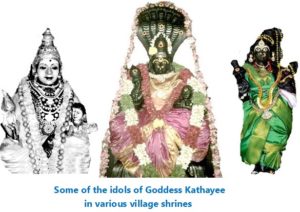
According to some folklore she was one amongst the seven Saptha Kannikas guarding Goddess Parvathi while few others say that she was the daughter of Saint Kathyayana. The arguments appear to be incorrect as no puranic evidence is adduced and they are based on folk lore only. As per the legend of Kaattumannar temple the child held by the lady (claimed as Goddess Kathayee by locals) in her lap was none but Lord Muruga only. The mute question that raise before us is as to why the female deity should carry Lord Muruga in the form of a child? Perhaps this belief might have stemmed out of the puranic story in which Goddess Kathayee was one of the Saptha Kannikas (seven virgin ladies) who picked up child Muruga from the reed bush and brought him up after the divine energies of both Lord Shiva and Goddess Parvathi merged and created Lord Muruga in the form of a child and left him lying in reed bush near a river. However none doubt that Goddess Kathayee in her original form of Goddess Valli was consort of Lord Muruga.
Learned pundits suggest the appearance of Goddess Kathayee holding a child symbolize that those who may practice the path of a child which remains free of worries, lust, greed and desire will be caressed and protected by her like her own child. These are word of mouth views spread over years or told in the form of folk songs in villages.
………continued -2

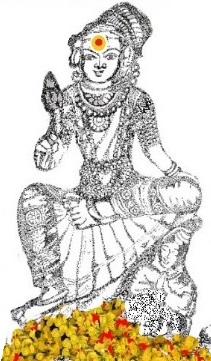

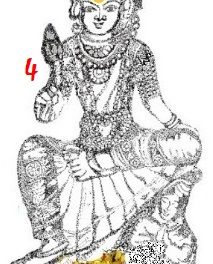
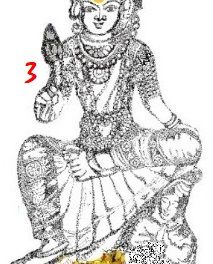
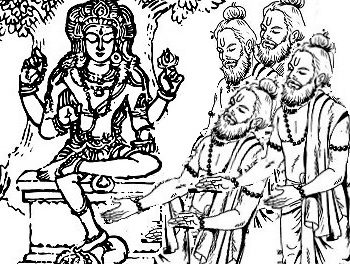


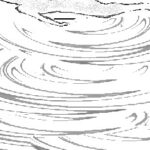
Thank you Sir for such a nice article. I reside in Singapore and my kula deivam is ‘Sitthadi Katthayee amman’.
Your article has now enriched my knowledge which i think i can pass on to my future generations